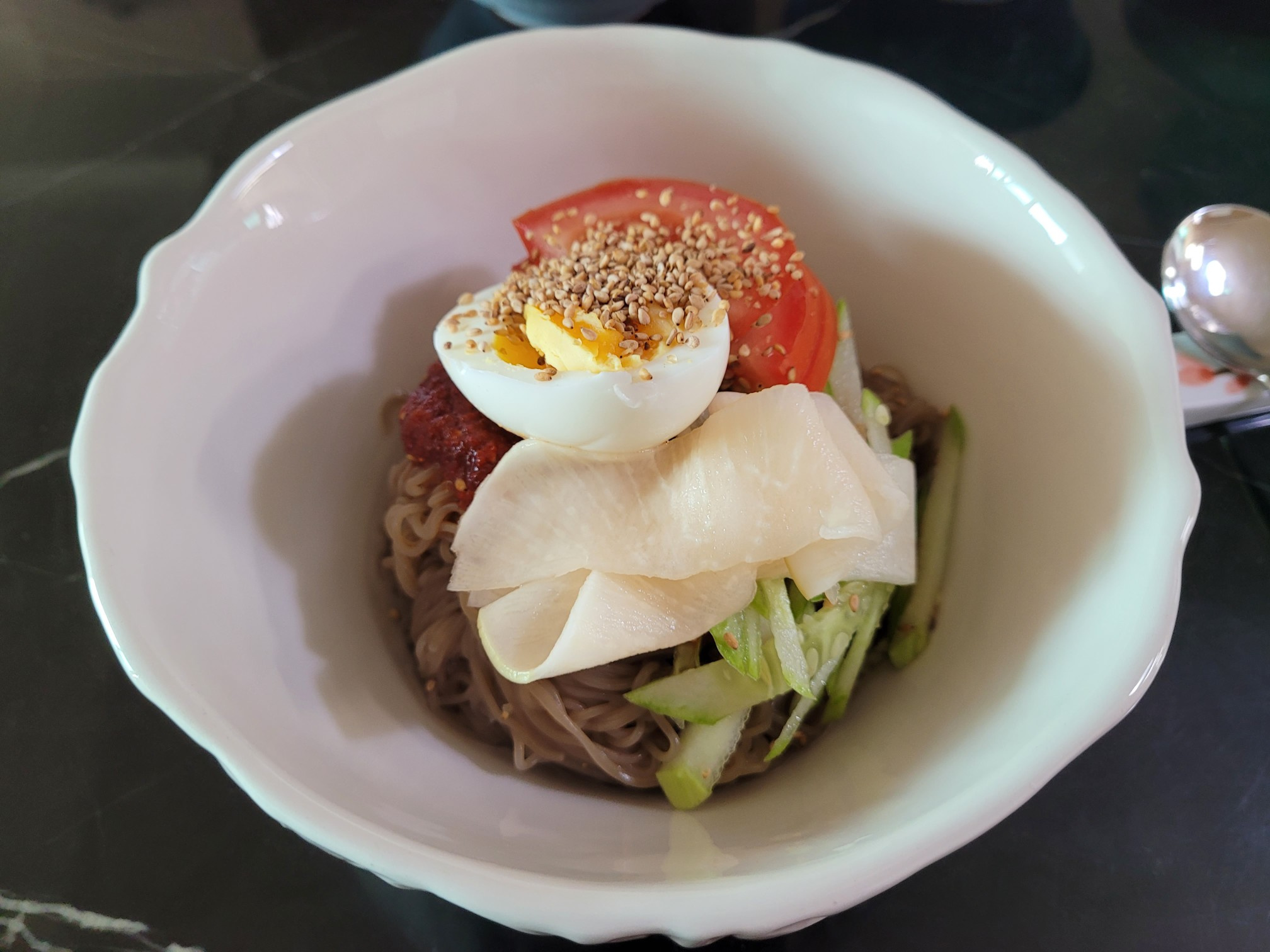Golden Ratio! Delicious Bibim-Naengmyeon Sauce
Enjoying Cold Bibim-Naengmyeon at Home: A Special Bibim Sauce Recipe Even Better Than Restaurants

Naengmyeon (cold noodles) is a beloved dish in our household year-round, and as the summer heat intensifies, the craving for refreshing naengmyeon grows even stronger. Today, I’m sharing a special bibim sauce recipe perfect for those who prefer noodles over rice when enjoying hearty meats like samgyeopsal (pork belly) or galbi (ribs). This recipe yields a generous amount, so get ready to enjoy delicious, cool bibim-naengmyeon conveniently at home this summer!
Fruits & Vegetables- Apple 100g (approx. 1/4 apple)
- Pear 100g (approx. 1/4 pear)
- Onion 100g (approx. 1/4 onion)
- Ginger 15g (approx. 1 small knob)
Seasoning Ingredients- Gochugaru (Korean chili flakes) 1 paper cup (approx. 80g)
- Jinganjang (soy sauce) 1/2 paper cup (approx. 100ml)
- Water 1/2 paper cup (approx. 100ml)
- Mulyeot (corn syrup) 1/2 paper cup (approx. 100ml)
- Sugar 2 Tbsp
- Maesilcheong (plum extract) 2 Tbsp
- Sesame oil 2 Tbsp
- Vinegar 2 Tbsp
- Sesame seeds 2 Tbsp
- Minced garlic 2 Tbsp
- Salt 1 Tbsp
- Gochugaru (Korean chili flakes) 1 paper cup (approx. 80g)
- Jinganjang (soy sauce) 1/2 paper cup (approx. 100ml)
- Water 1/2 paper cup (approx. 100ml)
- Mulyeot (corn syrup) 1/2 paper cup (approx. 100ml)
- Sugar 2 Tbsp
- Maesilcheong (plum extract) 2 Tbsp
- Sesame oil 2 Tbsp
- Vinegar 2 Tbsp
- Sesame seeds 2 Tbsp
- Minced garlic 2 Tbsp
- Salt 1 Tbsp
Cooking Instructions
Step 1
First, to make it easier to blend in the mixer, peel and chop the apple, pear, onion, and ginger into roughly 2cm cubes. This preparation ensures a smoother texture for the sauce.

Step 2
Place the cubed apple, pear, onion, and ginger into a blender, along with the specified amount of jinganjang (soy sauce). Blend until all ingredients are smooth and well combined. The natural moisture from the fruits and onion will help create a very smooth sauce base.

Step 3
Pour the blended fruit and vegetable mixture into a large bowl. Now, add the gochugaru (Korean chili flakes), 1 paper cup, and whisk it in, ensuring there are no clumps. Gradually incorporate the chili flakes for an even distribution.

Step 4
Mix the gochugaru thoroughly into the base until the seasoning paste is evenly combined. If you prefer a spicier kick, consider using a hotter variety of gochugaru. You can adjust the type of chili flakes to suit your preference for heat.

Step 5
Next, add all the remaining seasoning ingredients to the bowl. This includes 1/2 cup jinganjang (soy sauce), 1/2 cup water, 1/2 cup mulyeot (corn syrup), 2 Tbsp sugar, 2 Tbsp maesilcheong (plum extract), 2 Tbsp sesame oil, 2 Tbsp vinegar, 2 Tbsp sesame seeds, 2 Tbsp minced garlic, and finally, 1 Tbsp salt. Stir everything well to combine.

Step 6
Stir all the seasoning ingredients together until everything is uniformly mixed and no lumps remain. While you can use the bibim sauce immediately, for the best flavor, transfer it to an airtight container and let it age in the refrigerator for at least 2-3 days. This resting period allows the flavors to meld together beautifully, resulting in a more delicious and complex bibim-naengmyeon sauce.

Step 7
With this versatile bibim-naengmyeon sauce, you can effortlessly prepare not only refreshing mul-naengmyeon (watery cold noodles) and spicy bibim-naengmyeon but also use it as a flavor base for other noodle dishes like bibim-guksu or jjolmyeon, adding variety to your meals.

Step 8
Boil the naengmyeon noodles according to package instructions, then rinse them under cold water and drain well. Place the noodles in a serving bowl. Add a generous amount of the fermented kimchi water (dongchimi broth) or even a splash of cider for sweetness, then top with a hearty portion of the aged bibim-naengmyeon sauce.

Step 9
With this delicious bibim-naengmyeon sauce, you can recreate the delightful flavors of famous naengmyeon restaurants right in your own home. Enjoy a wonderful and satisfying naengmyeon meal with your entire family!




